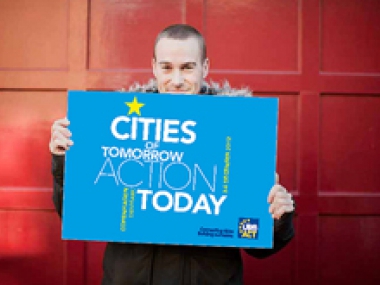From crisis to innovation
Edited on
11 February 2015The six workstreams charged with investigating how Europe’s cities move towards sustainable urban development outline their challenges and their initial conclusions.

 Besides the More Jobs workstream, the other five working groups who have been reviewing URBACT project results will also be presenting their findings in Copenhagen. They agree that capitalisation is the result of a long-lasting effort that has started to pay off. The workstreams have already come up with recommendations on social innovation that resonate with citizens. AsSally Kneeshaw, of Mobility Mindsets, says, such measures act as “a kind of glue, linking urban priorities”.
Besides the More Jobs workstream, the other five working groups who have been reviewing URBACT project results will also be presenting their findings in Copenhagen. They agree that capitalisation is the result of a long-lasting effort that has started to pay off. The workstreams have already come up with recommendations on social innovation that resonate with citizens. AsSally Kneeshaw, of Mobility Mindsets, says, such measures act as “a kind of glue, linking urban priorities”.
Motivating Mobility Mindsets

This workstream has drawn on the Electric Vehicles in Urban Europe network and Active Travel, as well as ENTER.HUB.
“We have been exploring a new concept of mobility linked to a social vision of the city in which mobility measures can act like a kind of glue, linking urban priorities,” says its coordinator, Sally Kneeshaw. She points out that effective mobility planning can link disadvantaged neighbourhoods to the jobs and services they need.
“This new mobility is built on a systemic, holistic approach, in which city stakeholders need to come together to build consensus and find joint solutions,” she says. “It requires mobility mindsets and long-term vision.”
Building Energy Efficiency
The coordinator is Antonio Borghi, who is also lead expert on the LINKS URBACT project, so naturally the team has made use of this study of retrofitting heritage buildings. It also absorbed the findings of the CASH and HerO networks.
“The capitalisation process is ongoing,” Antonio Borghi says, “but this has felt like a highly necessary process for cities. In the workshop sessions we are going to stress how energy efficient retrofitting can be a key driver for economic, social and environmental sustainable development.”
Supporting young people through social innovation

One of three workstreams highlighting the social problems of Europe’s cities, this one focuses on disconnected youth, and has drawn on the results of a number of URBACT projects including Co-Net, My Generation, PREVENT, TOGETHER and Roma-Net.
Eddy Adams, the coordinator, says that while cities hit by budget cuts are struggling to support the most marginalised in society, there are signs that some are viewing the crisis as an opportunity to promote social innovation. “Supporting some of our most vulnerable people with fewer resources is a shared challenge,” he says. Cities taking on this challenge were developing new civic leadership models, characterised by a desire for new working relationships and a willingness to take risks.
Against Divided Cities

This workstream looked at four specific cities studied in URBACT projects. Coordinator Iván Tosics explains: “Two of them, Malmö and Berlin, belong to countries where the welfare state is still strong and thedivision of the city into richer and poorer areas is not yet very advanced. France is less successful in this, as the Lyon suburb of Vaulx-en-Velin shows. Then Naples, with its Scampia estate, is one of the most segregated areas of Europe.”
He hopes the workshop will prove that less segregated cities perform better in most aspects of life. “Segregation makes the poor invisible,” he says, “thus besides improving the situation in ghettoes, links have to be created between rich and poor areas.”
Shrinking Cities

This group assesses the complex issues that produce population loss, including low fertility rates, ageing and migration. It draws on URBACT projects such as Active A.G.E.
Hans Schlappa, organiser of theCopenhagen workshop, says it will focus on three issues: adapting the physical infrastructure, such as dealing with derelict buildings; rebalancing services to suit the needs of an ageing population; and reimagining the city. “Accepting that your city is in decline and developing a new vision that resonates with citizens is difficult to accomplish and presents less visible but equally significant challenges for cities,” he says.
Submitted by admin on
